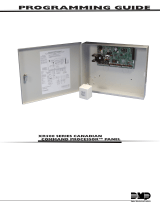Page is loading ...

1 CHANNEL TRANSMITTES & RECEIVERS
Installation Manual
TRANSMITTERS & RECEIVERS
FOR GENERAL SWITCHING
Single Channel pre-coded Sets
Receivers have an open collector or relay output
PTX001/PRX001 – Open Collector Output Set (1 Key Fob + 1 Receiver)
PTX001/PRX001R – Relay Output Set (1 Key Fob + 1 Receiver)
PTX001 – Additional Key Fob Transmitters
PTX001L – Additional Key Fob Transmitters with Large Button
PRX001 – Additional Open Collector Output Receiver
PRX001R – Additional Relay Output Receiver
Applications:
Emergency/Panic/Intrusion
System Arm/Disarm or On/Off
Lighting Control
Garage Door Control
Electric Shutter/Awning Control
General Switching
Features:
Low cost – excellent performance
Highly functional – multiple purpose
433.92 MHz – ETSI 300/220
Learn up to 20 Transmitters to each Receiver
Typical range between 30 to 70M depending
upon the Environment in which it is being used
Receivers can be selected as having a momentary
Output or a toggle latching output
Receiver Connections:
Each Receiver is supplied with two screws to secure the
Housing to a suitable surface. There are 4 wires protruding
from the PRX001 and 5 from the PRX001R (relay version).
The connections are:
GREEN - ANTENNA – DO NOT SHORTEN
RED - POSITIVE VOLTAGE CONNECTION (10 – 16V)
BLACK - 0V CONNECTION
BLUE - OUTPUT
WHITE - COMMON OUTPUT FOR PRX001R RELAY
VERSION
PRX001 Receiver Output
The PRX001 has a single wire open collector output that goes High on activation. The Drive output is a maximum of 500mA.
Do not overload the output.
PRX001R Receiver Output
The PRX001R has a relay output that goes from closed to open on activation. The Drive output is a maximum of 1A.
Do not overload the output
Technical Specifications:
Colour: PTX001 & PRX001 – Black
PTX001L - White
Receiver Voltage Supply: 10-16VDC
Transmitter Battery: 1 x GP23A (12V)
Transmitter Current Consumption:
Operating: 5mA Stand-by: 0mA
Receiver Current Consumption:
Operating: 7mA Stand-by: 6mA
Operating Temperature: -10 to + 65C
Receiver Circuit: Super-regenerative
Drive Output: 1A (Relay) .5A (Transistor)
Size:
PTX001 58 x 35 x 13mm
PRX001 65 x 60 x 25mm

Coding your PTX001/PRX001 or PTX001/PRX001R Sets
To match a Transmitter to a Receiver, carefully proceed as follows. Remember that you can match a maximum of 20 different
Transmitters to each Receiver:-
1. Power up to Receiver to a 12VDC supply
2. Locate the small push button on the side of Receiver
3. Push down on the button and the adjacent Red LED will light up, you are now in “Learning Mode”
4. Cause a transmission from one of the Transmitters you wish to learn to the Receiver. If successful, the LED will turn off and
the Receiver will exit the self-learn mode. That Transmitter has now been learnt to that Receiver. Repeat the process
from Step 2 above to learn additional Transmitters to that Receiver (max of 20). Note that you can learn the same
Transmitter to different Receivers.
5. If the Transmitter code is already in the Receiver’s memory, the LED will flash twice and stay in self-learn mode.
6. If the memory is full, the LED will flash 5 times.
7. If no Transmitter is activated within 120 seconds, the Receiver will automatically exit the self-learn mode.
8. To exit the self-learn mode manually, press the button again for at least 3 seconds.
9. To clear the Receiver memory completely of all Transmitters, power off the Receiver, then depress the push button. With
the button still depressed, reconnect power to the Receiver. The LED will flash twice and the self-learn mode will
automatically be entered.
Range Testing your Transmitter
With power connected to the Receiver, cause a transmission from the Transmitter. The RED LED on the side of the Receiver
will light up indicating successful receipt of that transmission. Note that if the Receiver has been selected as having a
Momentary Output, then the LED will light up briefly. If the Receiver has been selected as having a Toggle Latching Output,
the LED will remain lit until a subsequent successful transmission.
Selecting a Momentary or Toggle Latching Output
Using a small Phillips screwdriver, unscrew the 2 screws on the bottom of the Receiver Housing. Carefully prize the two
sections apart and turn the printed circuit board over. Locate the black 2 Pin Jumper marked J1 just above and to the left of
the push button. If the Link on this Jumper is just connected to one of the Pins, then the Receiver has been selected for a
momentary Output (factory default setting). If the Link is connected to both Pins, the Receiver has been selected for a toggle
latching Output (the first transmission activates the output and the output will remain activated until a successful second
transmission).
Trouble Shooting for No Operation or Poor Operation:
* Check that the Transmitter Battery is good.
* Check that the Receiver is being powered by the correct voltage.
* Make sure the Receiver is not placed inside a metal cabinet, the antenna is straight and not curled, there is no local
electromagnetic or RF interference and that it is not being used in a location where a large amount of metal or dense brick is
used in the construction of the walls or ceiling.
* Ensure the Transmitter has actually been learnt to the Receiver.
* Check that the outputs have not been overloaded.
* Check the system for any loose wiring.
Keystone Electronics Ltd
Tel: +44 (0)1305 851575 Email: sales@keystone-electronics.co.uk Web: www.keystone-electronics.co.uk
/





